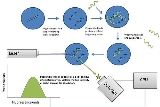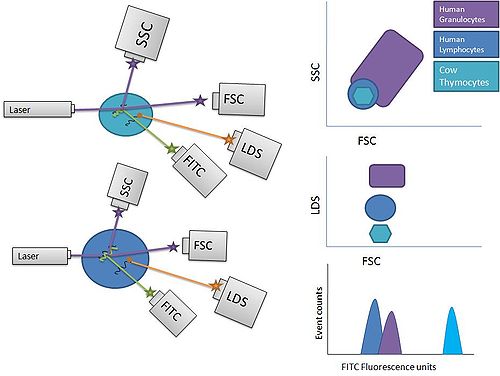
Flow-FISH
Encyclopedia
Flow-FISH is a cytogenetic technique to quantify the copy number of specific repetitive elements in genomic DNA
of whole cell populations via the combination of flow cytometry
with cytogenetic fluorescent in situ hybridization
staining protocols. Flow-FISH is most commonly used to quantify the length of telomeres, which are stretches of repetitious DNA
(hexameric TTAGGG repeats) at the distal ends of chromosomes in human white blood cells, and a semi-automated method for doing so was recently published in Nature Protocols. Telomere
length in white blood cell
s has been a subject of interest because telomere length in these cell types (and also of other somatic
tissues) declines gradually over the human lifespan, resulting in cell senescence
, apoptosis
, or transformation
. This decline has been shown to be a surrogate marker for the concomitant decline in the telomere length of the hematopoietic stem cell pool, with the granulocyte lineage giving the best indication, presumably due to the absence of a long lived memory subtype and comparatively rapid turnover of these cells.
, that employs peptide nucleic acid probes of a 3'-CCCTAACCCTAACCCTAA-5' sequence labeled with a fluorescin fluorophore
to stain telomeric repeats on prepared metaphase
spreads of cells that have been treated with colcemid
, hypotonic shock, and fixation
to slides via methanol
/acetic acid
treatment(protocol available online). Images of the resultant fluorescent spots could then be analyzed via a specialized computer program (method and software available from the Flintbox Network) to yield quantitative fluorescence values that can then be used to estimate actual telomere length. The fluorescence yielded by probe staining is considered to be quantitative because PNA binds preferentially to DNA at low ionic salt concentrations and in the presence of formamide
, thus the DNA duplex may not reform once it has been melted and annealed to PNA probe, allowing the probe to saturate its target repeat sequence (as it is not displaced from the target DNA by competing anti sense DNA on the complementary strand), thus yielding a reliable and quantifiable readout of the frequency of PNA probe target at a given chromosomal site after washing away of unbound probe.
----

----
DNA
Deoxyribonucleic acid is a nucleic acid that contains the genetic instructions used in the development and functioning of all known living organisms . The DNA segments that carry this genetic information are called genes, but other DNA sequences have structural purposes, or are involved in...
of whole cell populations via the combination of flow cytometry
Flow cytometry
Flow cytometry is a technique for counting and examining microscopic particles, such as cells and chromosomes, by suspending them in a stream of fluid and passing them by an electronic detection apparatus. It allows simultaneous multiparametric analysis of the physical and/or chemical...
with cytogenetic fluorescent in situ hybridization
Fluorescent in situ hybridization
FISH is a cytogenetic technique developed by biomedical researchers in the early 1980s that is used to detect and localize the presence or absence of specific DNA sequences on chromosomes. FISH uses fluorescent probes that bind to only those parts of the chromosome with which they show a high...
staining protocols. Flow-FISH is most commonly used to quantify the length of telomeres, which are stretches of repetitious DNA
DNA
Deoxyribonucleic acid is a nucleic acid that contains the genetic instructions used in the development and functioning of all known living organisms . The DNA segments that carry this genetic information are called genes, but other DNA sequences have structural purposes, or are involved in...
(hexameric TTAGGG repeats) at the distal ends of chromosomes in human white blood cells, and a semi-automated method for doing so was recently published in Nature Protocols. Telomere
Telomere
A telomere is a region of repetitive DNA sequences at the end of a chromosome, which protects the end of the chromosome from deterioration or from fusion with neighboring chromosomes. Its name is derived from the Greek nouns telos "end" and merοs "part"...
length in white blood cell
White blood cell
White blood cells, or leukocytes , are cells of the immune system involved in defending the body against both infectious disease and foreign materials. Five different and diverse types of leukocytes exist, but they are all produced and derived from a multipotent cell in the bone marrow known as a...
s has been a subject of interest because telomere length in these cell types (and also of other somatic
Somatic
The term somatic means 'of the body',, relating to the body. In medicine, somatic illness is bodily, not mental, illness. The term is often used in biology to refer to the cells of the body in contrast to the germ line cells which usually give rise to the gametes...
tissues) declines gradually over the human lifespan, resulting in cell senescence
Senescence
Senescence or biological aging is the change in the biology of an organism as it ages after its maturity. Such changes range from those affecting its cells and their function to those affecting the whole organism...
, apoptosis
Apoptosis
Apoptosis is the process of programmed cell death that may occur in multicellular organisms. Biochemical events lead to characteristic cell changes and death. These changes include blebbing, cell shrinkage, nuclear fragmentation, chromatin condensation, and chromosomal DNA fragmentation...
, or transformation
Malignant transformation
Malignant transformation is the process by which cells acquire the properties of cancer. This may occur as a primary process in normal tissue, or secondarily as malignant degeneration of a previously existing benign tumor....
. This decline has been shown to be a surrogate marker for the concomitant decline in the telomere length of the hematopoietic stem cell pool, with the granulocyte lineage giving the best indication, presumably due to the absence of a long lived memory subtype and comparatively rapid turnover of these cells.
Q-FISH to flow-FISH
Flow-FISH was first published in 1998 by Rufer et al. as a modification of another technique for analyzing telomere length, Q-FISHQ-FISH
Quantitative Fluorescent in situ hybridization is a cytogenetic technique based on the traditional FISH methodology. In Q-FISH, the technique uses labelled synthetic DNA mimics called peptide nucleic acid oligonucleotides to quantify target sequences in chromosomal DNA using fluorescent...
, that employs peptide nucleic acid probes of a 3'-CCCTAACCCTAACCCTAA-5' sequence labeled with a fluorescin fluorophore
Fluorophore
A fluorophore, in analogy to a chromophore, is a component of a molecule which causes a molecule to be fluorescent. It is a functional group in a molecule which will absorb energy of a specific wavelength and re-emit energy at a different wavelength...
to stain telomeric repeats on prepared metaphase
Metaphase
Metaphase, from the ancient Greek μετά and φάσις , is a stage of mitosis in the eukaryotic cell cycle in which condensed & highly coiled chromosomes, carrying genetic information, align in the middle of the cell before being separated into each of the two daughter cells...
spreads of cells that have been treated with colcemid
Colcemid
Used in cytogenetics, colcemid, also known as demecolcine, is related to colchicine but it is less toxic. It depolymerises microtubules and limits microtubule formation , thus arresting cells in metaphase and allowing cell harvest and karyotyping to be performed.-Mechanism of Action:Colcemid is a...
, hypotonic shock, and fixation
Fixation (histology)
In the fields of histology, pathology, and cell biology, fixation is a chemical process by which biological tissues are preserved from decay, thereby preventing autolysis or putrefaction...
to slides via methanol
Methanol
Methanol, also known as methyl alcohol, wood alcohol, wood naphtha or wood spirits, is a chemical with the formula CH3OH . It is the simplest alcohol, and is a light, volatile, colorless, flammable liquid with a distinctive odor very similar to, but slightly sweeter than, ethanol...
/acetic acid
Acetic acid
Acetic acid is an organic compound with the chemical formula CH3CO2H . It is a colourless liquid that when undiluted is also called glacial acetic acid. Acetic acid is the main component of vinegar , and has a distinctive sour taste and pungent smell...
treatment(protocol available online). Images of the resultant fluorescent spots could then be analyzed via a specialized computer program (method and software available from the Flintbox Network) to yield quantitative fluorescence values that can then be used to estimate actual telomere length. The fluorescence yielded by probe staining is considered to be quantitative because PNA binds preferentially to DNA at low ionic salt concentrations and in the presence of formamide
Formamide
Formamide, also known as methanamide, is an amide derived from formic acid. It is a clear liquid which is miscible with water and has an ammonia-like odor. It is used primarily for manufacturing sulfa drugs and synthesizing vitamins and as a softener for paper and fiber...
, thus the DNA duplex may not reform once it has been melted and annealed to PNA probe, allowing the probe to saturate its target repeat sequence (as it is not displaced from the target DNA by competing anti sense DNA on the complementary strand), thus yielding a reliable and quantifiable readout of the frequency of PNA probe target at a given chromosomal site after washing away of unbound probe.

----
Innovation
Unlike Q-FISH, Flow-FISH utilizes the quantitative properties of telomere specific PNA probe retention to quantify median fluorescence in a population of cells, via the use of a flow cytometer, instead of a fluorescence microscope. The primary advantage of this technique is that it eliminates the time required in Q-FISH to prepare metaphase spreads of cells of interest, and that flow cytometric analysis is also considerably faster than the methods required to acquire and analyze Q-FISH prepared slides. Flow-FISH thus allows for a higher throughput analysis of telomere length in blood leukocytes, which are a readily available form of human tissue sample. The most recent versions of the flow-FISH technique include an internal control population of cow thymocytes with a known telomere length detected by TRF or telomere restriction fragment analysis to which the fluorescence of a given unknown sample may be compared. Because cow thymocytes take up LDS751 dye to a lesser extent than their human counterparts, they may be reliably differentiated via plotting and gating the desired populations. Other cell types that have not in the past proven to be good candidates for flow-FISH can be analyzed via extraction of nuclei and performance of the technique on them directly.
Advantages
- Highly reproducible results
- Possible to analyze subsets of cells using physical and immunofluorescent markers.
- Better throughput than Q-FISH
- Possible to acquire fluorescence data on thousands of cells
Published protocol
Flow cytometry and FISH to measure the average length of telomeres (flow FISH)----

